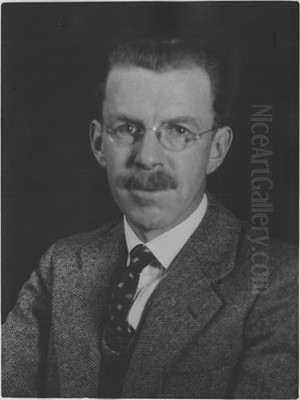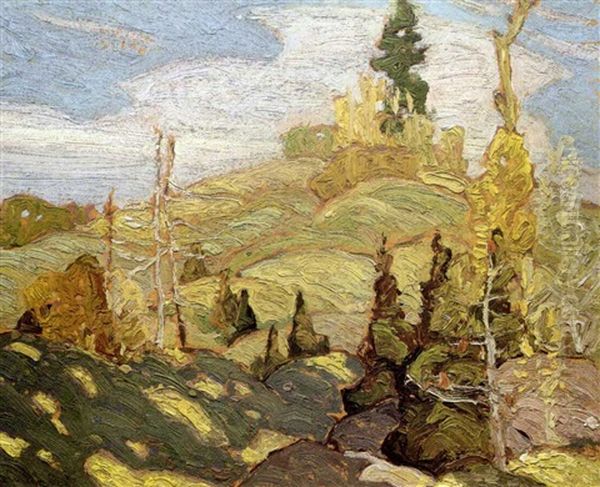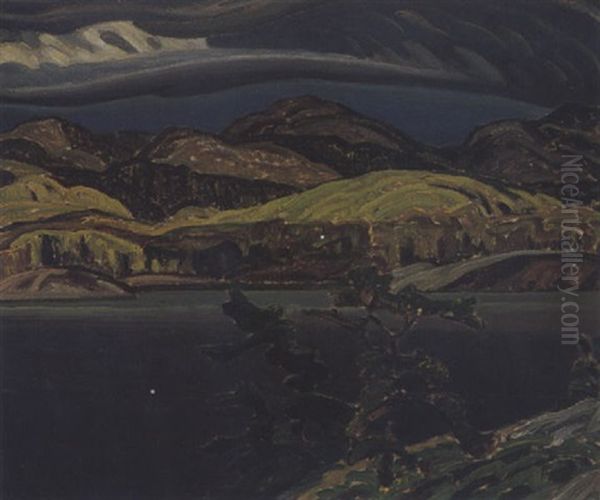
Franklin Carmichael stands as a pivotal figure in the annals of Canadian art, a founding member of the iconic Group of Seven, and an artist whose delicate yet powerful interpretations of the Ontario landscape continue to resonate. Though often noted as the youngest of the original Group, his contributions were profound, particularly his mastery of watercolour and his unwavering dedication to capturing the unique spirit of his native land. His life and work offer a compelling narrative of artistic development, collaborative spirit, and a deep connection to the natural world, cementing his legacy as a cornerstone of Canadian modernism.
Early Life and Artistic Awakening in Orillia
Born on May 4, 1890, in Orillia, Ontario, Franklin Carmichael's early environment was one of craftsmanship and nascent industrial change. His father, a carriage maker, instilled in young Franklin an appreciation for design and meticulous work. The family's Scottish-Canadian heritage likely contributed to a sense of resilience and a connection to tradition. Orillia, situated in the picturesque Lake Country region, provided an early immersion in the landscapes that would later define his artistic oeuvre. Even in his youth, Carmichael displayed a keen interest in art, and his mother, recognizing his talent, encouraged his pursuits by arranging music and art lessons.
His formative years involved practical experience in his father's shop, where he honed skills in decorating carriages. This hands-on work with design, line, and colour, though seemingly utilitarian, laid an essential foundation for his later artistic endeavors. It taught him the importance of precision and the effective use of materials, principles that would become evident in his mature works, especially his finely wrought watercolours. This early exposure to applied arts also perhaps sowed the seeds for his later successful career in commercial design and his influential role as an educator in the field.
Toronto: Forging an Artist's Path

At the age of twenty, in 1910, Carmichael made the decisive move to Toronto, a burgeoning city that was rapidly becoming the epicentre of artistic activity in Canada. He enrolled at the Ontario College of Art (OCA), now OCAD University, where he studied under prominent Canadian artists William Cruickshank and George Reid. These instructors, while rooted in more traditional European academic styles, provided him with essential technical training in drawing and painting. Cruickshank, known for his genre scenes and portraits, and Reid, a figure painter and muralist who also served as the OCA's principal, exposed Carmichael to established artistic conventions.
Concurrently, Carmichael sought practical experience. He began an apprenticeship at Grip Ltd., a prominent commercial art firm in Toronto, for a modest weekly wage of .50. This move proved to be incredibly fortuitous. Grip Ltd. was a crucible of talent, employing several artists who would become his lifelong colleagues and fellow revolutionaries in Canadian art. It was here he encountered J.E.H. MacDonald, Arthur Lismer, Frederick Varley, and Frank Johnston. Tom Thomson, another pivotal figure in the development of Canadian landscape painting, also worked there for a time. The atmosphere at Grip was one of creative ferment, where artists discussed new ideas and techniques, often influenced by European Art Nouveau and Arts and Crafts movements.
The camaraderie forged at Grip Ltd. extended beyond the workplace. Carmichael, along with Thomson, MacDonald, Lismer, and Varley, began undertaking weekend sketching trips to the countryside surrounding Toronto. These excursions were vital for developing their skills in plein air painting and for fostering a shared vision of depicting the Canadian landscape in a new, authentic way, distinct from European traditions. Tom Thomson, in particular, became a close friend and a significant influence, his passionate engagement with the wilderness inspiring Carmichael and others.
European Sojourn and Return
In 1913, seeking to broaden his artistic horizons, Carmichael traveled to Antwerp, Belgium, to study at the Académie Royale des Beaux-Arts. Europe, at this time, was a hotbed of artistic innovation, with movements like Post-Impressionism, Fauvism, and Cubism challenging established norms. While his time in Antwerp was relatively brief, it would have exposed him to these currents and provided a different perspective on art and technique. He immersed himself in his studies, likely focusing on life drawing and painting, further refining the skills he had begun to develop in Toronto.

However, the outbreak of World War I in 1914 abruptly cut short his European studies. Like many expatriates, Carmichael found it necessary to return to Canada. He arrived back in Ontario, his artistic development enriched by his experiences abroad but now facing a world dramatically altered by conflict. He resumed his work in commercial art, joining the firm Rous & Mann, where J.E.H. MacDonald also worked. He also reconnected with his fellow artists, sharing a studio space in the newly constructed Studio Building in Rosedale, a venture financed by Lawren Harris and Dr. James MacCallum, which became a hub for the artists who would form the Group of Seven.
The war years were a period of gestation for the nascent movement. While some artists, like A.Y. Jackson and F.H. Varley, served overseas, those who remained, including Carmichael, Harris, and MacDonald, continued to explore the Canadian landscape, particularly the Algoma region and areas around Georgian Bay, often inspired by Tom Thomson's pioneering work in Algonquin Park. Thomson's tragic death by drowning in 1917 was a profound loss to the group but also served to galvanize their resolve to pursue their shared artistic vision.
The Group of Seven: A New Vision for Canadian Art
The formal establishment of the Group of Seven occurred in 1920. The founding members were Franklin Carmichael, Lawren Harris, A.Y. Jackson, Frank Johnston, Arthur Lismer, J.E.H. MacDonald, and F.H. Varley. Their inaugural exhibition, held at the Art Gallery of Toronto (now the Art Gallery of Ontario) in May of that year, was a bold declaration of their artistic intentions. They sought to create a distinctly Canadian school of landscape painting, one that captured the rugged, untamed spirit of the nation's wilderness with a modern sensibility, moving away from the muted palettes and picturesque conventions of earlier Canadian art.
Carmichael, as the youngest founding member, brought a fresh perspective and a particular sensitivity to the group. While he shared the collective passion for the northern landscape, his artistic voice possessed a unique lyrical quality. His early works from this period often featured bold designs, rich colours, and a decorative sensibility, perhaps reflecting his background in commercial art and an affinity for Art Nouveau aesthetics. He participated in the Group's sketching expeditions to Algoma, the North Shore of Lake Superior, and later, the La Cloche Hills, which would become a signature subject for him.

Despite his integral role as a founder, Carmichael sometimes felt, and was perceived by some, as being slightly on the periphery of the Group, partly due to his age and perhaps his quieter demeanor compared to some of the more outspoken members like Lismer or Jackson. However, his commitment to the Group's ideals was unwavering, and his artistic contributions were significant. He served as the Group's president from 1932 to 1934, a period that saw the Group expand and eventually dissolve to make way for a larger, more inclusive organization.
Carmichael's Artistic Style: Watercolour and the Northern Light
While Carmichael worked proficiently in oils, it is for his mastery of watercolour that he is most celebrated. He began to focus more intensely on this medium around 1924, drawn to its translucency, immediacy, and ability to capture subtle atmospheric effects. He found watercolour particularly suited to expressing the delicate interplay of light and shadow in the Ontario landscape, the crispness of the northern air, and the vibrant, fleeting colours of the changing seasons.
His early watercolours, like his oils, often displayed a strong sense of design and pattern, with broad, flat areas of colour. Works like Autumn Hillside (1920) showcase this approach, with its rhythmic arrangement of forms and rich, autumnal palette. As his style evolved, Carmichael developed a greater interest in conveying depth, volume, and a more nuanced sense of space. He became particularly adept at depicting the vast, rolling skies and the reflective surfaces of water that are characteristic of the Canadian Shield.
The La Cloche Hills, a range of quartzite mountains north of Georgian Bay, became a cherished sketching ground for Carmichael from the mid-1920s onwards. He built a cabin there with fellow artists A.J. Casson and J.E.H. MacDonald, and the region inspired some of his most iconic works. His paintings of this area, such as La Cloche Silhouette (1939) and the oil painting Grace Lake (c. 1939), often feature panoramic views, with dramatic cloud formations and a focus on the ethereal quality of light filtering through the atmosphere. He was fascinated by how light interacted with the landscape, creating patterns and moods that were both specific and universal.
His design background remained an influential undercurrent in his fine art. Compositions were carefully considered, often employing strong diagonal lines and a balanced interplay of positive and negative space. This is evident in works like October Gold (1922), an oil painting that captures the brilliance of autumn foliage with a dynamic, almost tapestry-like quality, and A Northern Silver Mine (1930), which combines industrial subject matter with his characteristic landscape sensibility.
Representative Works: Capturing the Essence of Ontario

Several key works exemplify Franklin Carmichael's artistic vision and technical skill. The Upper Ottawa, near Mattawa (1924), an oil painting, demonstrates his ability to handle complex compositions and capture the rugged beauty of the northern river systems. The painting is characterized by its strong forms, vibrant colour, and a sense of the immense scale of the wilderness.
Old Barns, Miner's Bay (1924) is another significant oil, showcasing his interest in rural architecture and the human presence within the landscape. The work uses somewhat exaggerated forms and rich colours to convey a sense of enduring, weathered structures, hinting at a narrative of human endeavor against the backdrop of nature.
His watercolour Jackfish Village (1926) captures a remote settlement on the North Shore of Lake Superior, a subject also tackled by Lawren Harris and A.Y. Jackson. Carmichael’s interpretation, however, often focused on the interplay of light on the buildings and the surrounding water, rendered with his characteristic clarity and precision in the watercolour medium.
Perhaps one of his most celebrated watercolours is La Cloche (1933), also known as La Cloche Panorama. This expansive work masterfully depicts the rolling hills and vast sky of his beloved La Cloche region. The handling of the medium is exquisite, with transparent washes creating a luminous atmosphere and a profound sense of depth. The subtle gradations of colour in the sky and the delicate rendering of the distant hills showcase his mature command of watercolour.
Later works, such as the watercolour Snow Clouds (1938), continue to explore atmospheric effects, capturing the dramatic beauty of a winter sky over a snow-covered landscape. These pieces often convey a sense of solitude and contemplation, reflecting a deep spiritual connection with the natural world, a sentiment shared by Lawren Harris, though expressed in Carmichael's unique visual language.
A Dedicated Educator and Advocate for the Arts
Beyond his own artistic practice, Franklin Carmichael was deeply committed to art education and the promotion of Canadian art. In 1932, he took on a significant role at his alma mater, the Ontario College of Art, becoming the Head of the Graphic Design and Commercial Art department. He held this position until his death in 1945, influencing a generation of Canadian artists and designers. His practical experience in commercial art, combined with his fine art sensibilities, made him an effective and respected teacher. He understood the importance of strong foundational skills in drawing and design, as well as the need for creative exploration.
Carmichael was also instrumental in founding organizations that aimed to support and exhibit the work of Canadian artists. In 1925, recognizing the need for a dedicated platform for watercolourists, he co-founded the Ontario Society of Painters in Water Colour (OSPW) along with A.J. Casson and F.H. Brigden. This society played a crucial role in elevating the status of watercolour painting in Canada, which had often been considered secondary to oil painting. Carmichael served as its president for several years, championing the medium he so excelled in.
The Canadian Group of Painters and Later Years
The Group of Seven officially disbanded in 1933. While their impact had been immense, the members felt that the original impetus of the Group had run its course and that a new, broader organization was needed to represent the evolving landscape of Canadian art. That same year, the Canadian Group of Painters (CGP) was formed, with many former Group of Seven members, including Carmichael, playing key roles. Carmichael was a founding member and served as its first president. The CGP aimed to be more national in scope and inclusive in its membership, embracing a wider range of styles and artists from across the country, including figures like L.L. FitzGerald from Manitoba and Montreal-based artists like Edwin Holgate (who had become a later member of the Group of Seven).
Throughout the 1930s and early 1940s, Carmichael continued to paint prolifically, primarily focusing on the La Cloche region and other parts of Northern Ontario. He also undertook commercial design projects, creating illustrations for books and advertisements, demonstrating a versatility that bridged the worlds of fine art and applied art. His work from this period shows a continued refinement of his watercolour technique and a deepening exploration of light, atmosphere, and spiritual expression in landscape. He often sought out high vantage points for his compositions, giving his landscapes a sense of expansiveness and grandeur.
His interactions with other artists remained important. His friendship with A.J. Casson, who shared his passion for watercolour and design, was particularly enduring. They often sketched together and collaborated on initiatives like the OSPW. While he may have been the youngest of the original Seven, his quiet dedication and consistent artistic output earned him the respect of his peers, including Lawren Harris, whose own artistic journey took him towards abstraction, and A.Y. Jackson, who remained a steadfast champion of landscape painting.
Legacy and Enduring Influence
Franklin Carmichael passed away in Toronto on October 24, 1945, at the relatively young age of 55. His death marked the loss of a significant talent in Canadian art. His legacy, however, is multifaceted and enduring. As a founding member of the Group of Seven, he was instrumental in forging a new national artistic identity, one rooted in the direct experience of the Canadian wilderness. His paintings offered a vision of Canada that was both rugged and lyrical, powerful and serene.
His championing of watercolour as a serious medium for artistic expression was a crucial contribution. Through his own exquisite works and his role in the OSPW, he helped to elevate the status of watercolour painting in Canada, inspiring countless artists to explore its unique possibilities. His dedication to art education at the Ontario College of Art also left an indelible mark, shaping the skills and perspectives of future generations of Canadian artists and designers. He instilled in his students a respect for craftsmanship, a keen eye for design, and an appreciation for the Canadian landscape.
Today, Carmichael's works are held in major public and private collections across Canada and internationally, including the National Gallery of Canada, the Art Gallery of Ontario, and the McMichael Canadian Art Collection. His paintings, particularly his luminous watercolours of the La Cloche Hills, continue to be admired for their technical brilliance, their evocative beauty, and their profound connection to the spirit of the Canadian landscape. He remains a beloved figure, an artist who, while perhaps less flamboyant than some of his contemporaries like Arthur Lismer or Frederick Varley, possessed a deep artistic integrity and a unique ability to translate the soul of the wilderness onto paper and canvas. His influence can be seen in the work of subsequent Canadian landscape painters who continued to explore the themes and regions he pioneered.
Conclusion: A Quiet Force in Canadian Art
Franklin Carmichael's journey from a carriage maker's son in Orillia to a leading figure in Canadian modernism is a testament to his talent, dedication, and quiet perseverance. While he navigated the dynamic and sometimes boisterous world of the Group of Seven as its youngest member, he carved out a distinct artistic identity characterized by a refined sense of design, a mastery of watercolour, and a profound empathy for the landscapes of Northern Ontario. His collaborations with artists like Tom Thomson, J.E.H. MacDonald, Lawren Harris, A.Y. Jackson, and A.J. Casson were vital to the development of a national art, but his individual voice, lyrical and deeply felt, remains his most enduring legacy. Through his art and his teaching, Franklin Carmichael not only helped to define a Canadian vision but also left an inspiring body of work that continues to invite contemplation and celebrate the enduring beauty of the natural world.